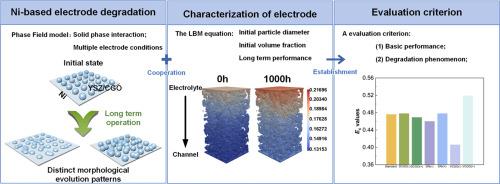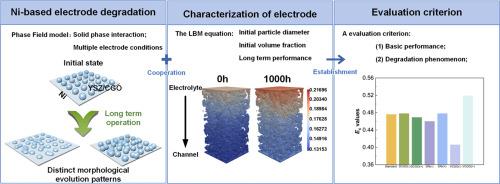微观结构演化驱动的镍基SOFC阳极降解:来自中尺度模拟的见解
IF 5.6
3区 材料科学
Q1 ELECTROCHEMISTRY
引用次数: 0
摘要
镍基阳极复合材料(Ni/YSZ和Ni/CGO)的降解机制对固体氧化物燃料电池(SOFCs)的电化学性能和耐久性有重要影响。尽管取得了显著的进展,但镍基电极的形态演变与长期电化学降解之间的复杂关系仍然没有得到充分的阐明。本文介绍了一种新的中尺度模型框架,该框架将相场模型(PFM)和晶格玻尔兹曼方法(LBM)相结合,用于定量预测长期性能演变。开发的PFM阐明了电极内的成分和微观结构演变,捕获了复杂的相边界动力学。同时,LBM严格评估电化学反应途径和电荷转移电阻,提供了性能退化的多物理场视角。该模型使用MAD(中位数绝对偏差)进行了严格验证,初始电极结构、激活过电位和粒径增长的误差分别仅为1.8%、2.43%和4.1%。通过系统的参数研究,本工作量化了初始粒径和体积分数对降解和电化学性能相互作用的影响。在镍基电极中,离子导电相的体积分数越高,评价分数最高,分别达到47.8%和44.2%。这些发现建立了一个强大的性能评估框架,为微观结构演变对电极耐久性的协同效应提供了重要见解,并为下一代SOFC阳极的合理设计奠定了基础。本文章由计算机程序翻译,如有差异,请以英文原文为准。


Microstructural evolution-driven degradation of nickel-based SOFC anodes: Insights from mesoscale modeling
Degradation mechanisms in nickel-based anode composites (Ni/YSZ and Ni/CGO) critically influence the electrochemical performance and durability of solid oxide fuel cells (SOFCs). Despite notable advances, the complex relationship between morphological evolution and long-term electrochemical degradation in nickel-based electrodes remains insufficiently clarified. This study introduces a novel mesoscale modeling framework that integrates phase-field modeling (PFM) and the lattice Boltzmann method (LBM) to quantitatively predict long-term performance evolution. The developed PFM elucidates compositional and microstructural evolution within the electrode, capturing intricate phase boundary dynamics. Concurrently, the LBM rigorously evaluates electrochemical reaction pathways and charge transfer resistances, offering a multi-physics perspective on performance degradation. The model is rigorously validated using the MAD (Median Absolute Deviation), with errors of only 1.8%, 2.43%, and 4.1% for the initial electrode structure, activation overpotential, and particle size growth, respectively. Through systematic parametric studies, this work quantifies the influences of initial particle size and volume fraction on the interplay between degradation and electrochemical performance. In the case of nickel-based electrodes, a higher volume fraction of the ion-conducting phase led to the maximum evaluation scores, reaching 47.8% and 44.2%, respectively. These findings establish a robust performance evaluation framework, providing critical insights into the synergistic effects of microstructural evolution on electrode durability and establishing a foundation for rational design of next-generation SOFC anodes.
求助全文
通过发布文献求助,成功后即可免费获取论文全文。
去求助
来源期刊

Electrochimica Acta
工程技术-电化学
CiteScore
11.30
自引率
6.10%
发文量
1634
审稿时长
41 days
期刊介绍:
Electrochimica Acta is an international journal. It is intended for the publication of both original work and reviews in the field of electrochemistry. Electrochemistry should be interpreted to mean any of the research fields covered by the Divisions of the International Society of Electrochemistry listed below, as well as emerging scientific domains covered by ISE New Topics Committee.
 求助内容:
求助内容: 应助结果提醒方式:
应助结果提醒方式:


